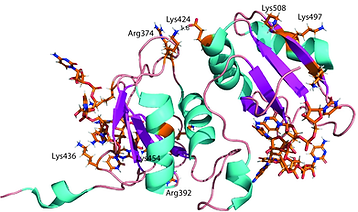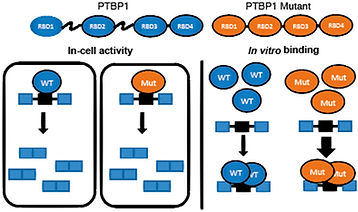
Publications
Sullivan ME, Edberg JA, Nunez CI, Axelrod HL, Keppetipola NM
June 4, 2025
RNA binding proteins play an important role in regulating alternative pre-mRNA splicing and in turn cellular gene expression. Polypyrimidine tract binding proteins, PTBP1 and PTBP2, are paralogous RNA binding proteins that play a critical role in the process of neuronal differentiation and maturation... Read More

Truong A, Barton M, Tran U, Mellody M, Berger D, Madory D, Hitch E, Jibrael B, Nikolaidis N, Luchko T, Keppetipola N
February 8, 2024
RNA Binding Proteins regulate, in part, alternative pre-mRNA splicing and, in turn, gene expression patterns. Polypyrimidine tract binding proteins PTBP1 and PTBP2 are paralogous RNA binding proteins sharing 74% amino acid sequence identity. Both proteins contain four structured RNA-recognition motifs... Read More

Pina JM, Hernandez LA, Keppetipola NM
February 3, 2022
RNA binding proteins play an important role in regulating alternative pre-mRNA splicing and in turn cellular gene expression. Polypyrimidine tract binding proteins, PTBP1 and PTBP2, are paralogous RNA binding proteins that play a critical role in the process of neuronal differentiation and maturation; changes in the concentration of PTBP proteins... Read More

Keppetipola N, Patchen T
March 31, 2021
Although many science education researchers have investigated developing science education at the K-12 levels to meet the needs of underrepresented students in science, far fewer have considered how shifts to online instruction in undergraduate science courses might provide insights into... Read More

Pimentel C, Le C, Tuttobene MR, Subils T, Martinez J, Sieira R, Papp-Wallace KM, Keppetipola N, Bonomo RA, Actis LA, Tolmasky ME, Ramirez MS
April 13, 2021
Acinetobacter baumannii is a nosocomial pathogen capable of causing serious infections associated with high rates of morbidity and mortality. Due to its antimicrobial drug resistance profile, A. baumannii is categorized as an urgent priority pathogen by the Centers for Disease... Read More

Ontiveros RJ, Hernandez L, Nguyen H, Hernandez Lopez AL, Shankar A, Kim E, Keppetipola N
December 22, 2020
Polypyrimidine tract binding protein 1 (PTBP1) is a well-studied RNA binding protein that serves as an important model for understanding molecular mechanisms underlying alternative splicing regulation. PTBP1 has... Read More

Martinez AA, Espinosa BA, Adamek RN, Thomas BA, Chau J, Gonzalez E, Keppetipola N, Salzameda NT
August 31, 2018
The West Nile virus (WNV) has spread throughout the world causing neuroinvasive diseases with no treatments available. The viral NS2B-NS3 protease is essential for WNV survival and replication in host cells and is a promising drug target. Through an enzymatic... Read More

Pina JM, Reynaga JM, Truong AAM, Keppetipola NM
July 3, 2018
RNA binding proteins play an important role in regulating alternative pre-mRNA splicing and in turn cellular gene expression. Many of these RNA binding proteins occur as gene families with members sharing a high degree of primary structure identity and domain... Read More

Keppetipola NM, Yeom KH, Hernandez AL, Bui T, Sharma S, Black DL
August 22, 2016
Most human genes generate multiple protein isoforms through alternative pre-mRNA splicing, but the mechanisms controlling alternative splicing choices by RNA binding proteins are not well understood. These proteins can have multiple paralogs expressed in different cell types and exhibiting different... Read More

Keppetipola N, Sharma S, Li Q, Black DL
June 2, 2012
Alternative splicing patterns are regulated by RNA binding proteins that assemble onto each pre-mRNA to form a complex RNP structure. The polypyrimidine tract binding protein, PTB, has served as an informative model for understanding how RNA binding proteins affect spliceosome... Read More

Keppetipola N, Jain R, Meineke B, Diver M, Shuman S
June 15, 2009
tRNA anticodon damage inflicted by secreted ribotoxins such as Kluyveromyces lactis gamma-toxin and bacterial colicins underlies a rudimentary innate immune system that distinguishes self from nonself species. The intracellular expression of gamma-toxin (a 232-amino acid polypeptide) arrests the... Read More

Keppetipola N, Shuman S
November 7, 2008
Binuclear metallophosphoesterases are an enzyme superfamily defined by a shared fold and a conserved active site. Although many family members have been characterized biochemically or structurally, the physiological substrates are rarely known, and the features that determine monoesterase versus diesterase... Read More

Keppetipola N, Shuman S
December 15, 2007
Clostridium thermocellum polynucleotide kinase-phosphatase ( Cth Pnkp) catalyzes 5′ and 3′ end-healing reactions that prepare broken RNA termini for sealing by RNA ligase. The central phosphatase domain of Cth Pnkp belongs to the dinuclear metallophosphoesterase superfamily exemplified by bacteriophage λ ...Read More

Keppetipola N, Nandakumar J, Shuman S
May 8, 2007
Programmed RNA breakage is an emerging theme underlying cellular responses to stress, virus infection and defense against foreign species. In many cases, site-specific cleavage of the target RNA generates 2′,3′ cyclic phosphate and 5′-OH ends. For the damage to be... Read More

Keppetipola N, Jain R, Shuman S
April 20, 2007
Triphosphate tunnel metalloenzymes (TTMs) are a newly recognized superfamily of phosphotransferases defined by a unique active site residing within an eight-stranded beta barrel. The prototypical members are the eukaryal metal-dependent RNA triphosphatases, which catalyze the initial step in mRNA capping. Read More

Keppetipola N, Shuman S
July 14, 2006
The central phosphatase domain of Clostridium thermocellum polynucleotide kinase/phosphatase (CthPnkp) belongs to the dinuclear metallophosphoesterase superfamily. Prior mutational studies of CthPnkp identified 7 individual active site side chains (Asp-187, His-189, Asp-233, Asn-263, His-323, His-376, and Asp-392) required for Ni2+-dependent... Read More

Mechanism of the phosphatase component of Clostridium thermocellum polynucleotide kinase-phosphatase
Keppetipola N, Shuman S
November 21, 2005
Polynucleotide kinase-phosphatase (Pnkp) from Clostridium thermocellum catalyzes ATP-dependent phosphorylation of 5'-OH termini of DNA or RNA polynucleotides and Ni(2+)/Mn(2+)-dependent dephosphorylation of 2',3' cyclic phosphate, 2'-phosphate, and 3'-phosphate ribonucleotides. CthPnkp is an 870-amino-acid polypeptide composed of three domains: an N-terminal... Read More

Keppetipola N, Shuman S
October 15, 2005
Archaea encode a DNA ligase composed of a C-terminal catalytic domain typical of ATP-dependent ligases plus an N-terminal domain similar to that found in eukaryotic cellular and poxvirus DNA ligases. All archaeal DNA ligases characterized to date have ATP-dependent adenylyltransferase... Read More
